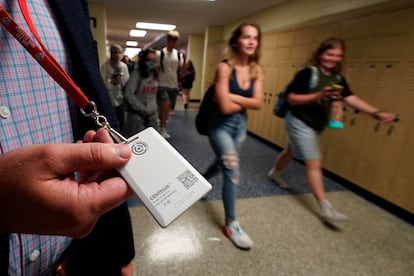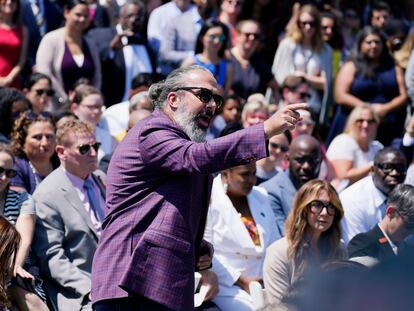Armed teachers and panic buttons: How US students are returning to school
Children face a new academic year in an atmosphere of anxiety and stress, and with the tragedy of Uvalde still fresh in their minds


The Uvalde massacre that left 21 dead in an elementary school last May still casts a long shadow in the academic community. The shooting took place at the end of May, just as the school year ended; with the return to the classrooms, parents’ concern for the safety of their children in the most gun-filled country in the world also increased. The 2021-2022 academic year was the most violent ever recorded in the classrooms: firearm incidents quadrupled in basic education centers (elementary through high school). In 2013 there were 49; last year there were 193, with 59 dead and 138 injured, according to research an investigation carried out by Everytown, a gun regulation advocacy group.
The tragedy brought forced changes throughout the country. The Madison County school district, one of 115 in North Carolina, reported that it will provide each of its schools with an AR-15 shotgun (in a safe) to respond to a possible incident like the one in Texas. In Kansas, a school district spent $2 million on a system of panic buttons that can activate emergency protocols. In Ohio, a Republican state, the government gave the green light to regulations that allow teachers to carry a weapon, requiring only 24 hours of training and an eight-hour annual refresher course. A police cadet needs 700 hours.
In Texas, the changes were cosmetic. For example, the doors and the surveillance of the entrance at a private school in a Houston neighborhood were reinforced, according to Daniela Taracena, a teacher there. With 5.5 million students in public schools, several of these invested in perimeter fencing and security cameras. Governor Greg Abbott sent 30 state law enforcement officers to Uvalde to keep watch over the first days of school.

At least 29 of the 50 states currently allow armed school staff, in addition to school district police and guards. In Uvalde, however, the presence of guns or authorities no longer makes anyone feel safe. Felix Rubio, Lexi’s father, voiced the general feeling when he said on public radio recently that there is simply nothing that can be done. His wife, Kimberley, complemented his words by saying that, even if there is a heavy police presence now, the police was also present at the school that day. Even in case of a threat, she no longer feels comfortable with the way they deal with this type of situations.
Greg Abbott, governor of Texas, did not yield to the main demand made by the relatives of the victims: to convene a special legislative session to reform the laws and prevent 18-year-olds from getting hold of an assault rifle like the one used by Salvador Ramos, the murderer. He said that such a change would be considered unconstitutional by the Supreme Court. Abbott is seeking reelection in November, but his Democratic rival has closed the gap in the polls; the way he managed the shooting is one of the reasons for his loss of popularity.
An analysis by Everytown shows that most of the weapons used in school shootings come from circles close to the murderer. Sarah Burd-Sharps, a researcher for the organization, notes that experts agree that the way to keep students and educators safe is by “acting on warning signs at the earliest stages and blocking easy access to firearms by those who would do harm.” Everytown is categorically opposed to the idea of arming teachers, an initiative that is supported by the American Federation of Teachers and the National Education Association. These groups represent a total of 4.6 million teachers.
A few days ago, an incident at a school in Oakland, California, made many fear the worst. The local press reported an alleged shooting that had left a 13-year-old injured and a 12-year-old in custody. The police ruled out a shooting: it was an accident, caused by a weapon in inexperienced hands. The event was enough to alter life within Madison Park Academy. Last Tuesday, the school opened its doors with therapists to help the students, but most of them stayed home. A 2021 survey estimates that around 4.6 million children in the United States live in homes with loaded guns that are not under lock and key.
Lilly Blanchard, a mother from Torrance (south of Los Angeles), says that the new school year, which in her district began on August 25, makes her feel extremely anxious. The main reason for her concern – and her outrage – is that the City Council approved the permits for a gun store to open near her son’s high school.
Depression in the classroom
Besides the weapons, the mental health of minors is another concern in this new school year. At the end of 2021, Vivek Murthy, the head of Public Health for the Joe Biden administration, warned of a national crisis that was aggravated by the pandemic and the economic downturn. Before the health emergency, the situation was already urgent: the authorities reported that one in three high school students presented symptoms of depression. Suicides among children and young people between the ages of 10 and 24 soared 57% between 2007 and 2018, and authorities estimate that in 2020 there were close to 6,600 suicides in this age group.
Things did not get any better during the last school year: 76% of public schools in the United States expressed concern about the increase in signs of anxiety, depression and trauma in students. “The pandemic has taken a clear and significant toll on the mental health of students,” said Peggy G. Carr, commissioner of the National Center for Education Statistics (NCES). Last week, the Department of Health and Human Services tried to tackle this problem by injecting $87 million to be used exclusively in mental health programs in educational centers.
There has also been a sharp drop in performance. Daniel McGrath, another of the NCES commissioners, recently reported that students’ academic performance is at a level last seen 20 years ago. The organization points out that reading comprehension has registered its most serious decline in 30 years for white, Black and Latino students (Asians and Native Americans remained at the same levels). Math skills also plummeted. The test scores of nine-year-olds dropped an average of seven points when compared to scores from two years ago. A new school year is beginning, and the most urgent tasks are very clear.
Tu suscripción se está usando en otro dispositivo
¿Quieres añadir otro usuario a tu suscripción?
Si continúas leyendo en este dispositivo, no se podrá leer en el otro.
FlechaTu suscripción se está usando en otro dispositivo y solo puedes acceder a EL PAÍS desde un dispositivo a la vez.
Si quieres compartir tu cuenta, cambia tu suscripción a la modalidad Premium, así podrás añadir otro usuario. Cada uno accederá con su propia cuenta de email, lo que os permitirá personalizar vuestra experiencia en EL PAÍS.
¿Tienes una suscripción de empresa? Accede aquí para contratar más cuentas.
En el caso de no saber quién está usando tu cuenta, te recomendamos cambiar tu contraseña aquí.
Si decides continuar compartiendo tu cuenta, este mensaje se mostrará en tu dispositivo y en el de la otra persona que está usando tu cuenta de forma indefinida, afectando a tu experiencia de lectura. Puedes consultar aquí los términos y condiciones de la suscripción digital.
More information
Archived In
Últimas noticias
Can cheese protect brain health? This is what the science says
The life of a delivery driver in China: ‘Many people don’t know how an order can arrive at their home in just one day’
Maude Apatow, from acting in ‘Euphoria’ to directing: ‘There are many films that you can tell weren’t written by someone young’
Helen Levitt, the photographer who captured the theater of the everyday
Most viewed
- Christian Louboutin: ‘Young people don’t want to be like their parents. And if their parents wear sneakers, they’re going to look for something else’
- US sanctions against jailed cartel leader ‘El Marro’ highlight Mexico’s lack of control over its prisons
- Cartels in Mexico take a leap forward with narco-drones: ‘It is criminal groups that are leading the innovation race’
- Liset Menéndez de la Prida, neuroscientist: ‘It’s not normal to constantly seek pleasure; it’s important to be bored, to be calm’
- ‘El Limones’ and the growing union disguise of Mexican organized crime










































